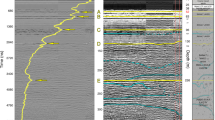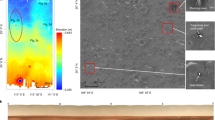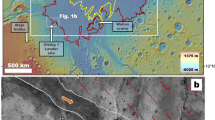Abstract
The South Pole–Aitken (SPA) basin is the oldest and largest impact structure on the Moon, and it gives particular insight on the lunar interior composition1,2,3. However, the surface of the SPA basin has been substantially modified by consequent impacts and basalt flooding. The exploration of the surficial material and the substructure of the SPA basin is one of the main scientific goals of the Chinese spacecraft Chang’E-4 that landed in the Von Kármán crater inside the SPA basin4,5. Here we report the lunar penetrating radar profiles along the track of the lunar rover Yutu-2, which show a three-unit substructure at the landing site. The top unit consists of the ~12-m-thick lunar regolith and ~120 m multilayered ejecta that were delivered from several adjacent craters. The middle unit is the mare basalts filling the Von Kármán crater. The lowest unit is another ejecta layer with a thickness of ≥200 m, likely from the Leibnitz crater. These discoveries fully support the local stratigraphy and geological explanation presented previously6. Our results reveal that the surface materials at the Chang’E-4 landing site are unambiguously dominated by the ejecta from the Finsen crater with a minor contribution from other neighbouring craters. The regolith measured by Yutu-2 is representative of the initial lunar deep interior materials, rather than the later erupted basalts.
This is a preview of subscription content, access via your institution
Access options
Access Nature and 54 other Nature Portfolio journals
Get Nature+, our best-value online-access subscription
$29.99 / 30 days
cancel any time
Subscribe to this journal
Receive 12 digital issues and online access to articles
$119.00 per year
only $9.92 per issue
Buy this article
- Purchase on Springer Link
- Instant access to full article PDF
Prices may be subject to local taxes which are calculated during checkout



Similar content being viewed by others
Data availability
The data used in this work is available on the Science and Application Center for Moon and Deep Space Exploration, Chinese Academy of Sciences (http://moon.bao.ac.cn).
Code availability
The code for processing the LPR data is available from the corresponding author on request.
References
Ohtake, M. et al. Geologic structure generated by large-impact basin formation observed at the South Pole–Aitken basin on the Moon. Geophys. Res. Lett. 41, 2738–2745 (2014).
Melosh, H. J. et al. South Pole–Aitken basin ejecta reveal the Moon’s upper mantle. Geology 45, 1063–1066 (2017).
Moriarty, D. P. III & Pieters, C. M. The character of South Pole–Aitken basin: patterns of surface and subsurface composition. J. Geophys. Res. Planets 123, 729–747 (2018).
Li, C. et al. Chang’e-4 initial spectroscopic identification of lunar far-side mantle-derived material. Nature 569, 378–382 (2019).
Wu, W. et al. Lunar farside to be explored by Chang’e-4. Nat. Geosci. 12, 222–223 (2019).
Stuart-Alexander, D. E. Geologic Map of the Central Far Side of the Moon Investigations Map Series I-1047 (USGS, 1978).
Peeples, W. J., Sill, W. R. & May, T. W. Orbital radar evidence for lunar subsurface layering in Maria Serenitatis and Crisium. J. Geophys. Res. Solid Earth 83, 3459–3468 (1978).
Sharpton, V. L. & Head, J. W. Stratigraphy and structural evolution of southern Mare Serenitatis: a reinterpretation based on Apollo Lunar Sounder Experiment data. J. Geophys. Res. Solid Earth 87, 10983–10998 (1982).
Ono, T. et al. Lunar radar sounder observations of subsurface layers under the nearside maria of the Moon. Science 323, 909–912 (2009).
Shkuratov, Y. G., Kaidash, V. G., Kreslavsky, M. A. & Opanasenko, N. V. Absolute calibration of the Clementine UVVIS data: comparison with ground-based observation of the moon. Sol. Syst. Res. 35, 29–34 (2001).
Petro, N. E. & Pieters, C. M. The lunar-wide effects of basin ejecta distribution on the early megaregolith. Meteorit. Planet. Sci. 43, 1517–1529 (2008).
Heiken, G. H., Vaniman, D. T. & French, B. M. Lunar Sourcebook: A User’s Guide to the Moon (Cambridge Univ. Press, 1991).
Montopoli, M., Tognolatti, P., Marzano, F. S., Pierdicca, M. & Perrotta, G. Remote sensing of the Moon sub-surface from a spaceborne microwave radiometer aboard the European Student Moon Orbiter (ESMO). In Proc. IEEE International Geoscience and Remote Sensing Symposium (IGARSS) 4451–4454 (2007).
Fa, W. Z. & Jin, Y. Q. A primary analysis of microwave brightness temperature of lunar surface from Chang’e-1 multi-channel radiometer observation and inversion of regolith layer thickness. Icarus 207, 605–615 (2010).
Hawke, B. R. & Head, J. W. Impact melt on lunar crater rims. In Impact and Explosion Cratering (eds Roddy, D. J. et al.) 815–841 (Pergamon Press, 1977).
Wilcox, B. B., Lucey, P. G. & Gillis, J. J. Mapping iron in the lunar mare: an improved approach. J. Geophys. Res. Planets 110, E11001 (2005).
Neish, C. D. et al. Spectral properties of Titan’s impact craters imply chemical weathering of its surface. Geophys. Res. Lett. 42, 3746–3754 (2015).
Zhang, J. H. et al. Volcanic history of the Imbrium basin: a close-up view from the lunar rover Yutu. Proc. Natl Acad. Sci. USA 112, 5342–5347 (2015).
Xiao, L. et al. A young multilayered terrane of the northern Mare Imbrium revealed by Chang’e-3 mission. Science 347, 1226–1229 (2015).
Choy, T. C. Effective Medium Theory: Principles and Applications (Oxford Univ. Press, 2015)
Huang, Q. & Wieczorek, M. A. Density and porosity of the lunar crust from gravity and topography. J. Geophys. Res. Planets 117, E05003 (2012).
Olhoeft, G. R. & Strangway, D. W. Dielectical properties of the first 100 meters of the Moon. Earth Planet. Sci. Lett. 24, 394–404 (1975).
Ivanov, M. A. et al. Geologic history of the northern portion of the South Pole–Aitken basin on the Moon. J. Geophys. Res. Planets 123, 2585–2612 (2018).
Huang, J. et al. Geological characteristics of Von Kármán crater, northwestern South Pole–Aitken basin: Chang’e-4 landing site region. J. Geophys. Res. Planets 123, 1684–1700 (2018).
Du, J. et al. Thickness of lunare mare basalts: new results based on modeling the degradation of partially buried craters. J. Geophys. Res. Planets 124, 2430–2459 (2019).
Di, K. et al. Topographic evolution of Von Kármán crater revealed by the lunar rover Yutu-2. Geophys. Res. Lett. 46, 12764–12770 (2019).
Li, C. et al. The Moon’s farside shallow subsurface structure unveiled by Chang’e-4 lunar penetrating radar. Sci. Adv. 6, eaay6898 (2020).
Moriarty, D. P. III & Pieters, C. M. The nature and origin of Mafic Mound in the South Pole–Aitken basin. Geophys. Res. Lett. 42, 7907–7915 (2015).
McGetchin, T. R., Settle, M. & Head, J. W. Radial thickness variation in impact crater ejecta: implications for lunar basin deposits. Earth Planet. Sci. Lett. 20, 226–236 (1973).
Fang, G. Y. et al. Lunar penetrating radar onboard the Chang’e-3 mission. Res. Astron. Astrophys. 14, 1607–1622 (2014).
Su, Y. et al. Data processing and initial results of Chang’e-3 lunar penetrating radar. Res. Astron. Astrophys. 14, 1623–1632 (2014).
Shen, S. et al. Design of dual-channel nonuniform digital sampling receiver for lunar penetrating radar in Chang’e-3 rover. IEEE Aerosp. Electron. Syst. Mag. 31, 22–31 (2016).
Cagnoli, B. & Ulrych, T. J. Singular value decomposition and wavy reflections in ground-penetrating radar images of base surge deposits. J. Appl. Geophys. 48, 175–182 (2001).
Di, K. C. et al. Chang’e-4 lander localization based on multi-source data. J. Remote Sens. 23, 177–180 (2019).
Claerbout, J. F. Imaging the Earth’s Interior (Blackwell Scientific, 1985).
Yilmaz, Ö. Seismic Data Processing (Society of Exploration Geophysicists, 1987).
Etgen, J., Gray, S. H. & Zhang, Y. An overview of depth imaging in exploration geophysics. Geophysics 74, WCA5–WCA17 (2009).
Stoffa, P. L. et al. Split-step Fourier migration. Geophysics 55, 410–421 (1990).
Wu, R. S. Wide-angle elastic wave one-way propagation in heterogeneous media and an elastic wave complex-screen method. J. Geophys. Res. 99, 751–766 (1994).
Lv, W. et al. Comparative analysis of reflection characteristics of lunar penetrating radar data using numerical simulations. Icarus 350, 113896 (2020).
Collins, G. S., Melosh, H. J. & Ivanov, B. A. Modeling damage and deformation in impact simulations. Meteorit. Planet. Sci. 39, 217–231 (2004).
Wünnemann, K., Collins, G. S. & Melosh, H. J. A strain-based porosity model for use in hydrocode simulations of impacts and implications for transient-crater growth in porous targets. Icarus 180, 514–527 (2006).
Amsden, A. A., Ruppel, H. M. & Hirt, C. W. SALE: A Simplified ALE Computer Program for Fluid Flow at all Speeds LANL Report LA-8095 (LANL, 1980).
Wünnemann, K., Zhu, M. H. & Stöffler, D. Impacts into quartz sand: crater formation, shock metamorphism, and ejecta distribution in laboratory experiments and numerical models. Meteorit. Planet. Sci. 51, 1762–1794 (2016).
Melosh, H. J. et al. The origin of lunar mascon basins. Science 340, 1552–1555 (2013).
Potter, R. W. K. et al. Constraining the size of the South Pole–Aitken basin impact. Icarus 220, 730–743 (2012).
Potter, R. W. K. et al. Numerical modeling of the formation and structure of the Orientale impact basin. J. Geophys. Res. 118, 963–979 (2013).
Zhu, M.-H., Wünnemann, K. & Potter, R. W. K. Numerical modeling of the ejecta distribution and formation of the Orientale basin on the Moon. J. Geophys. Res. 120, 118–2,134 (2015).
Zhu, M. H. et al. Are the Moon’s nearside-farside asymmetries the result of a giant impact? J. Geophys. Res. 124, 2117–2140 (2019).
Ahrens, T. J. & O’Keefe, J. D. Shock melting and vaporization of lunar rocks and minerals. In Impact and Explosion Cratering (eds Roddy, D. J. et al.) 639–656 (Pergamon Press, 1977).
Benz, W., Cameron, A. G. W. & Melosh, H. J. The origin of the Moon and the single-impact hypothesis III. Icarus 81, 113–131 (1989).
Wieczorek, M. A. et al. The crust of the Moon as seen by GRAIL. Science 339, 671–675 (2013).
Ivanov, B. A., Melosh, H. J. & Pierazzo E. in Large Meteorite Impacts and Planetary Evolution IV (eds Gibson, R. L. & Reimold, W. U.) 29–49 (Geological Society of America, 2010).
Melosh, H. J. Acoustic fluidization: a new geologic process? J. Geophys. Res. 84, 7513–7520 (1979).
Melosh, H. J. & Ivanov, B. A. Impact crater collapse. Annu. Rev. Earth Planet. Sci. 27, 385–415 (1999).
Zhu, M. H., Wünnemann, K. & Artemieva, N. Effects of Moon’s thermal state on the impact basin ejecta distribution. Geophys. Res. Lett. 44, 11292–11300 (2017).
Bottke, W. F. et al. An Archaean heavy bombardment from a destabilized extension of the asteroid belt. Nature 485, 78–81 (2012).
Le Feuvre, M. & Wieczorek, M. A. Nonuniform cratering of the Moon and a revised crater chronology of the inner Solar System. Icarus 214, 1–20 (2011).
Hörz, F., Ostertag, R. & Rainey, D. A. Bunte Breccia of the Ries: continuous deposits of large impact crater. Rev. Geophys. Space Phys. 21, 1667–1725 (1983).
Artemieva, N. A. et al. Ries crater and suevite revisited—observation and modeling. Part II: modeling. Meteorit. Planet. Sci. 48, 590–627 (2013).
Stöffler, D. et al. Experimental hypervelocity impact into quartz sand: distribution and shock metamorphism of ejecta. J. Geophys. Res. 80, 4062–4077 (1975).
Fortezzo, C. M. & Hare, T. M. Completed digital renovation of the 1:5,000,000 lunar geologic map series. Lunar Planet. Sci. Conf. 44, 2623 (2013).
Acknowledgements
The Chang’E-4 mission was carried out by the Chinese Lunar Exploration Program, and the data were provided by the China National Space Administration. We thank D. Moriarty for helpful suggestions, which greatly improved the clarity and readability of the manuscript. This work was supported by Key Research Program of Frontier Sciences, Chinese Academy of Sciences (QYZDJ-SSW-DQC001) and the National Nature Science Foundation of China (41490631 and 41941002). M.-H.Z. was supported by the Science and Technology Development Fund, Macau (0079/2018/A2) and the pre-research project on Civil Aerospace Technologies No. D020202 funded by China National Space Administration (CNSA). M.-H.Z. acknowledges the iSALE developers. H.S. was supported by the Beijing Municipal Science and Technology Commission (Z181100002918003) and the pre-research project on Civil Aerospace Technologies No. D020201 funded by China National Space Administration (CNSA). We thank the Supercomputing Laboratory of IGGCAS for providing computing resources.
Author information
Authors and Affiliations
Contributions
Yangting Lin lead the study; J.Z., B.Z., Yangtin Lin, H.S., Yi Lin, C.L. and Z. Yao processed and analysed the LPR data; Yangting Lin, M.-H.Z., J.Z., W.Y., K.D., Z. Yue and Z.O. interpreted the lunar geology; M.-H.Z. simulated impacting; B.Z., Z.D., Y.G., H.L., J.Y., E.L. and L.W. designed the payloads; Yangting Lin, J.Z., M.-H.Z. and H.S. prepared the manuscript.
Corresponding author
Ethics declarations
Competing interests
The authors declare no competing interests.
Additional information
Peer review information Nature Astronomy thanks Gareth Morgan and the other, anonymous, reviewer(s) for their contribution to the peer review of this work.
Publisher’s note Springer Nature remains neutral with regard to jurisdictional claims in published maps and institutional affiliations.
Extended data
Extended Data Fig. 1 The location of Chang’E-4 landing site and the track of Yutu-2 rover.
a, The farside of the Moon; b, Local details in the rectangle in a; c, Local details in the rectangle in b; d, Local details in the rectangle in c. a is obtained by the Lunar Resonant Orbiter (http://lroc.sese. asu.edu/posts/298); b and c are obtained by Chang’E-2 (http://moon.bao.ac.cn); d is obtained by the descending camera under the Chang’E-4 lander.
Extended Data Fig. 2 High resolution image of the Chang’E-4 landing site and the regional geology.
a, The Chang’E-4 landing site; b, The regional geology that modified from https://quickmap.lroc.asu.edu62.
Extended Data Fig. 3 The rareness of rocks on the lunar surface at the Chang’E-4 landing site.
The landscape images were taken with the panorama camera on the rover Yutu-2 (a) and by the terrain camera on the Chang’E-4 lander (b). The distance between two rows of wheels is ~80 cm.
Extended Data Fig. 4 The LPR data of Channel-1.
a, The raw data profile; b, The profile after using a bandpass filter between 10 and 80 MHz for each trace and a 2D median filter using parameters of (3,10). The depth is converted from the travel time using a relative dielectric model shown in Extended Data Fig. 7. The processed data shown in b is exactly the same as that shown in Fig. 2, which is shown here to examine the processing results compared with the original data shown in a.
Extended Data Fig. 5 Local zoom in of original waveforms of low-frequency LPR Channel from 0 to 1.4 μs.
a, The stack of three waveforms at the trace no. 500, 1000, and 1500. b, c, d, The independent waveforms at trace no. 500, 1000, and 1500, respectively. Note that only the waveforms within 0.31 μs (indicated by the orange arrow) have been apparently clipped and the rest are reliable.
Extended Data Fig. 6 Singular value decomposition of low-frequency channel.
a, The same profile as shown in Fig. 2. b, The low-pass eigenimage33 (only keeping eigenvalues from 1 to 10); c, the band-pass eigenimage (only keeping eigenvalues from 11 to 200); d, the high-pass eigenimage (only keeping eigenvalues from 201 to 1973). b~d share the same color scale but is slightly less clipped than a for the convenience of pattern comparison. The singular values are shown in Supplementary Fig. 5.
Extended Data Fig. 8 Comparison between the original LPR profile and the migration result.
a, The original LPR profile; b, The migration result. The data are obtained by the high-frequency Channel-2B. The local details in the rectangles are shown in Extended Data Fig. 9.
Extended Data Fig. 9 Local details in the rectangles in Extended Data Fig. 8.
a–c, The original LPR profiles; d–f, The corresponding migration results of a–c, respectively.
Extended Data Fig. 10 Comparison between the low-frequency and high-frequency LPR channels.
a, Low-frequency channel; b, High-frequency channel. The high-frequency channel can well constrain the subsurface structures within 0.62 μs.
Supplementary information
Supplementary Information
Supplementary Figs. 1–5 and Table 1.
Rights and permissions
About this article
Cite this article
Zhang, J., Zhou, B., Lin, Y. et al. Lunar regolith and substructure at Chang’E-4 landing site in South Pole–Aitken basin. Nat Astron 5, 25–30 (2021). https://doi.org/10.1038/s41550-020-1197-x
Received:
Accepted:
Published:
Issue Date:
DOI: https://doi.org/10.1038/s41550-020-1197-x
This article is cited by
-
Lunar rock investigation and tri-aspect characterization of lunar farside regolith by a digital twin
Nature Communications (2024)
-
Innovative developments in lunar and planetary science promoted by China’s lunar exploration
Science China Earth Sciences (2023)
-
Buried palaeo-polygonal terrain detected underneath Utopia Planitia on Mars by the Zhurong radar
Nature Astronomy (2023)
-
A solar wind-derived water reservoir on the Moon hosted by impact glass beads
Nature Geoscience (2023)
-
Layered subsurface in Utopia Basin of Mars revealed by Zhurong rover radar
Nature (2022)



